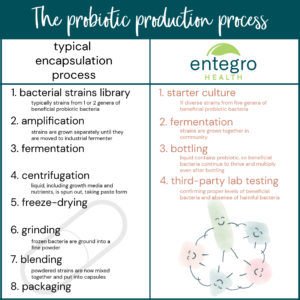General FAQ
Probiotics are live microorganisms that serve the purpose of balancing the gut microbiome and improving digestion to support overall health in the body.
Learn more about the microbiome in our blog.

The beneficial bacteria in Flourish are in their most natural state with their food source, even after they’ve been bottled. As thriving probiotics, they continue to live and metabolize which releases carbon dioxide and nitrogen, which in turn pressurizes a closed bottle. When opened, the pressure is released causing the liquid to bubble and fizz.
If your Flourish has been shipped, place it in the refrigerator for a few hours and slowly open and close as needed to reduce pressurization.
Yes. Flourish (Original and Junior) have been safely used in many children of various ages.
As with any supplement or medication, check with your healthcare practitioner before use if there are underlying or unusual health conditions.
Kombucha is more of a casual, leisure drink. Many people sip on a bottle of kombucha instead of coffee, tea, or soda as a “daily/habitual” beverage. Most popular brands of kombucha are labeled to contain 2 – 6 billion organisms in one 16 oz bottle, compared to the minimum of 8 billion organisms in one Tbsp of Flourish. One would have to drink four to five entire 16 oz bottles to get the same volume of probiotics that you would get from one Tablespoon of Flourish. And at 6-9 grams of sugar per serving, that adds up quickly!
Flourish is concentrated volume of bacteria to be used as a supplement rather than a leisurely sipping drink. Another significant difference between Flourish and kombucha is diversity of strains. Flourish contains eleven different strains of beneficial probiotics from five different genera: Lactobacillus, Bifidobacterium, Enterococcus, Bacillus, and Saccharomyces, whereas most kombuchas typically contain 2-4 strains. Also, the SCOBY or “mother culture” for kombucha most likely has different strains of bacteria than that of our product; therefore, adding diversity to our gut biome.
Could you do both? Absolutely. It is really hard, and quite frankly rare, to overdose on good gut bacteria.
Similar to kombucha, one would have to consume large servings of yogurt to get comparable levels of the good gut bacteria (One Tbsp of Flourish is equal to the probiotic count in about 10 Cups of yogurt!) Most yogurt products are not plain or unflavored; they have been loaded with added sugar or artificial sweeteners. Research is showing that simple refined sugars actually “feed” the bad gut bacteria and that artificial sweeteners are harmful to good gut bacteria. It is also important to note that most yogurts contain only Lactobacillus strains, not the diversity of strains contained within Flourish.
Absolutely. Sugar and simple refined starches “feed” the bad gut bacteria, making it more difficult for the good gut bacteria to get a foothold and take up residence.
New research is also suggesting that wheat, more specifically the proteins of gluten and gliadin contained within, has harmful effects on both the good gut bacteria and the intestinal wall lining. Other studies indicate that wheat contributes to the growth of bad bacteria.
One can begin to feed the good guys by reducing or eliminating sugar, simple refined starches, and wheat, and replacing them with vegetables, seeds, and fruits such as: psyllium seed husks, ground flax, chia seeds, prunes, berries, tree nuts, legumes, cabbages, onions, mushrooms, non-starchy greens, and colorful root vegetables.
Yes. Research is showing that probiotics are especially important in children born via Cesarean section. The most important thing to ever happen to your microbiome happens the moment you are born.
Babies born vaginally get their first major dose of microbes from their mothers as they pass through the birth canal. These beneficial bacteria include Lactobacillus, which helps breakdown the lactose in milk to make energy. More Lactobacilli colonize the mother’s vagina as her due date nears, ready to jump ship to her baby, helping to digest breast milk.
Babies delivered via C-section surgery get their first dose of microbes from their mother’s skin and the skin of doctors and nurses in the delivery room.
Add items to your cart. In checkout, add your Promo Code and click the green Add Code button. Click blue Checkout button to complete your purchase.
We do not offer samples. However, the 30 Day Challenge is available to new clients.
It is generally considered safe for infants to use probiotics.
Suggested use of Flourish (Original or Junior) for those under 12 months old: 0-3 months use 0.25 ml daily; 3-6 months use 0.5 ml daily; 6-9 months use 0.75 ml daily; 9-12 months use 1 ml daily. These are suggested starting doses. Doses can be adjusted for tolerability and outcomes. We recommend using a properly calibrated oral dosing syringe to correctly measure smaller doses.
When first taking a probiotic, your baby’s gut microbiome adjusts. Your baby may experience minor bloating, gas, or intestinal gurgling, which should subside with continued use. Consult your healthcare provider if symptoms continue after two weeks.
PRECAUTION: Keep out of reach of children. Inform a healthcare professional before starting any dietary supplement, particularly if there is a known immune-compromised condition. If your child develops an allergic reaction, such as rash, itching, wheezing, or hives, discontinue use and call your doctor.
If you don't see your questions answered, please contact us at [email protected].
 New customers! Get 11% OFF your first Flourish order with Code FRESHSTART11
New customers! Get 11% OFF your first Flourish order with Code FRESHSTART11

